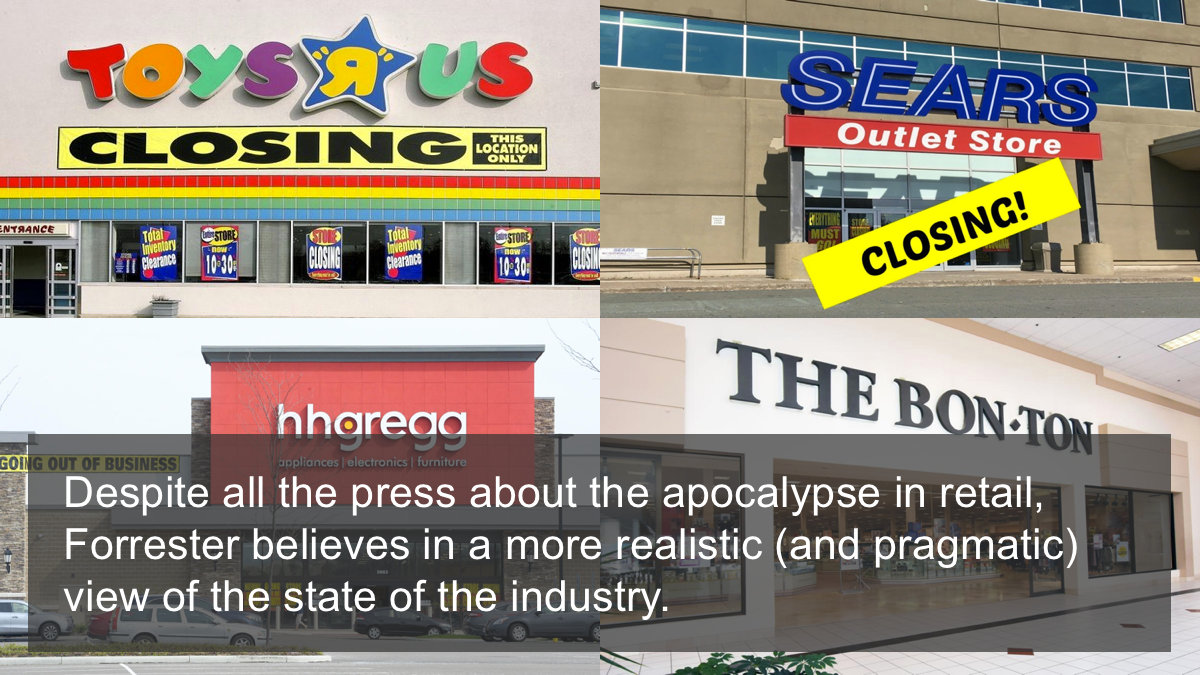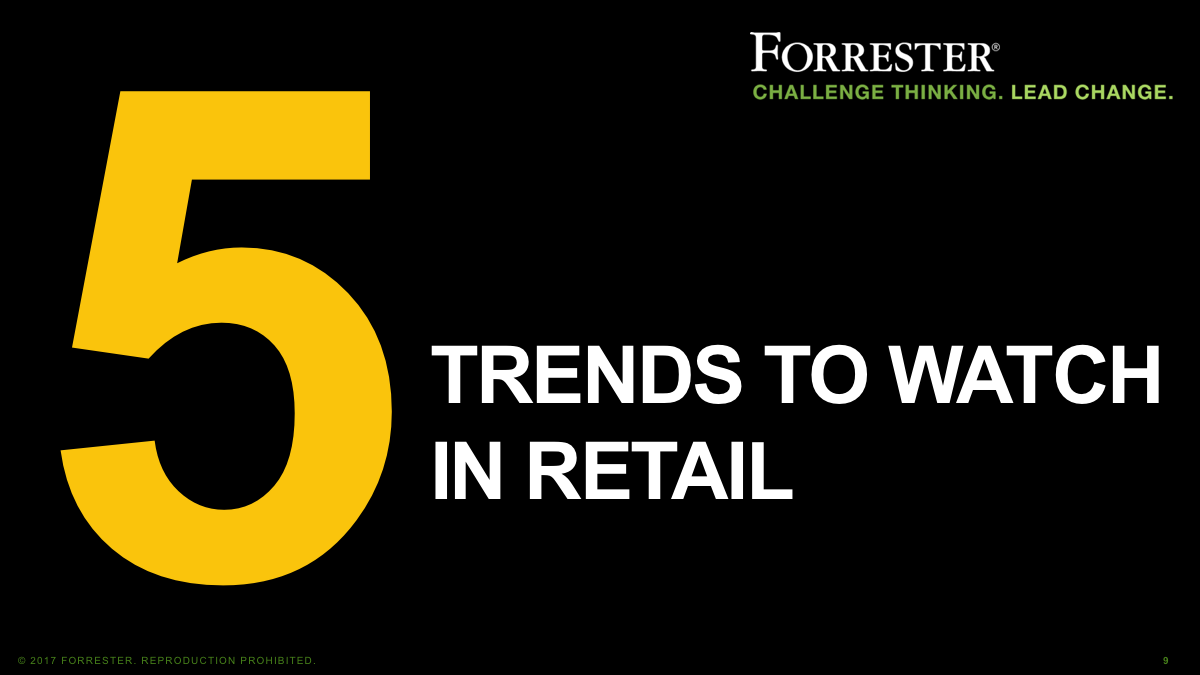
While chain store closings continue to send shockwaves across the business world, new Forrester research – “Apocalypse, Schmapocalypse: What’s Really Happening in Retail” – finds that a majority of multi-location brick and mortars are experiencing positive sales growth this year.
To find out why many are thriving while others are closing their doors, Netsertive hosted a lively discussion with Forrester and one of the retailers bucking the store closing trend: Serta Simmons Bedding’s 300-location America’s Mattress retailer network.
In part one below, Jay McBain, Principal Analyst at Forrester, notes that while there isn’t a retail apocalypse, there is a retail evolution happening, and senior-level executives need to catch up. Jay focuses on the massive disruptions (and opportunities) brought by e-commerce players. He points to the influence of web research on in-store “considered purchases” as a key opportunity for retailers looking to buck the store closing trend.
In part three, Tim McLain, Segment Marketing Manager at Netsertive, presents three national retailer case studies, showing how their investments in new marketing technology are driving consistent digital messages to local customers, who in turn buy in-store.
In part two, Jay is joined by Stephen Day, Senior Manager of Program Development at Serta Simmons Bedding. Stephen reveals how America’s Mattress retailers who’ve invested in local digital marketing this year have seen an 11% increase.
Tim McLain: Welcome to our “How to Thrive in the National Retail Evolution” webinar. We’re excited to have all of you on the line and we have a lot of great content to share today. First, we’re going to show you how to nail and scale your national retail marketing in a “click to brick” economy. We’re going to learn what that means and how to get the most out of it, with tips to adjust your marketing to match. Next, we’re going to show you how three national brick and mortar retailers are winning customers, outsmarting their e-commerce competitors, by leveraging their local retailers with centrally-controlled, multichannel digital campaigns. Finally, you’re going to see some real hands-on examples of how these retailers have localized their digital marketing at scale and are driving fantastic results in their businesses.
To begin, I want to give a special welcome to Jay McBain, he’s a Principal Analyst at Forrester. He’s renowned for his thought leadership around partner recruitment and acceleration by leveraging the technology Netsertive offers to its clients, what Forrester calls Through Channel Marketing Automation or TCMA.

Just this week we were excited to learn that Netsertive was included in the top 15 TCMA providers. We’re listed as a Strong Performer in Jay’s Forrester Wave report for Q2 2018, with Netsertive receiving the highest possible score in the product vision criterion. Our references noted the strengths of our “speed of execution, breadth of multiple media channels and integration requirements, targeting parameters and brand compliance.” This speaks directly to our core focus on execution of distributed digital marketing at the local level and simplifying the complex requirements of the brand and multi-location retail networks, which is the perfect way to begin today’s webinar. Jay, take it away!
Jay McBain: Thank you so much, Tim. Retail is one of my favorite subjects to talk about, there are nearly 30 different retail industries. When you get into a group of people, whether it’s at an industry event or just on the street, it seems like everyone wants to talk about the state of the retail industry. They have their own examples and opinions, so at Forrester, we try to level set what the press is propagating about the industry.

If you were just to read the headlines you’d think that retail was dying, that there’s some sort of “retail apocalypse” that’s happening. We see it much more realistically. We get the benefit of reviewing company financials both public and private, we look at U.S government organizations. The good news is that retail is an industry that’s growing. It survived the recession from ten years ago and it’s been growing ever since.
Other than some high profile bankruptcies which we all know and follow and some struggles that are happening in different places, retail is actually fine and well … we’re seeing some very good growth in places like restaurants and personal care which is which is leading a lot of the growth. We’re seeing some single-digit decline in smaller single stores, what we used to call mom and pop shops, there’s some demographic turnover, some aging owners of these smaller businesses. But overall, since before 2008 versus after 2008, the retail industry has been growing.
I’m excited to have Stephen on the call today from Serta because it’s the big ticket sectors that are doing particularly well, especially retailers selling what we call considered purchases [products or services costing $500 or more].

The home category is up 16% over the past year. The stock markets are at their highest levels, the unemployment rate is at its lowest level in decades, and consumer confidence is high. So we’re seeing not only the home category but automotive, travel, healthcare and beauty all growing in the double digits this year. Really, the only shrinkage is in electronics. But overall the retail industry is one that’s growing, opening stores, and doing extremely well in the market.

Amazon. It’s the elephant in the room, so every time you read an article in the newspaper or access social media, it’s about how Amazon is taking over the world. We asked 4,500 people how they’re buying from Amazon, they tell us it’s clothing, footwear, and accessories. Plus, they came from the book industry, so that does extremely well. But when you look at the hundreds of retail categories, you notice that Amazon isn’t making an impact as broadly as the perception out there would say.

I want to quickly go through five trends that we’re watching here at Forrester. We all know that consumers spend and shopping behaviors are changing. Retail is not alone, there are dozens of other industries also going disruptions thanks to emerging technologies. Most [businesses] have done a pretty good job of understanding what those changes are, what the customer buying journey looks like today, and are paying attention to what it is going to look like in the years to come. The first trend that we’re seeing is the need for every retailer to have an Amazon strategy.

Looking at different categories, you know what happens when retailers with a huge logistics and supply chain come up against the e-commerce giants. Amazon comes in and attacks where it sees a new business growth area. Retailers need to understand that there are lots of opportunities and areas to fire up in terms of adjacent types of opportunities. We’re seeing a ton of mergers and acquisitions, many launching new types of programs and offerings for their loyal consumers, and how to align these deals with a broader wallet chain.

Second, we’re seeing malls changing. Anyone who’s walked into a mall recently is seeing shuttered stores, we’re seeing a lot of turnover. The days of having the two anchors on the ends and these multi-decade long leases is going away in terms of a more real-time need, almost a transactional or a transience nature, with pop up stores and services businesses. We’re seeing a different landscape in terms of opportunities that fire up and fire down during the holiday cycle. That’s really the model of where we’re going.

Our third trend is around retail concepts, they’re dying much faster and there are multiple new opportunities that open up often. Retailers must be agile, nimble, be ready to drive innovation and get things fired up quickly knowing that going from zero to viral is happening faster than it ever has in history. And we know they can die just as fast. So, you’ve got to have that innovative culture internally and you’ve got to plan for quick obsolescence, many of these product lines and even full categories are being disrupted.

My fourth trend is that small is big in retail. In many stores we’re seeing small square footage being set aside for innovative environments, think of store within a store. The is how Serta is putting their mattresses into America’s Mattress Galleries inside existing local furniture stores, which Stephen will talk about in a moment. You need to think of innovative spaces where partnerships can happen. I talked earlier about adjacencies, additional swim lanes that store owners are recognizing where partnerships can put new products in-store that go together.
I was just saying before this call that today I’m literally moving from New York to Florida and I’ve got two moving trucks outside right now. I was telling my wife that of all the bedrooms here, I’m going to need new mattresses this weekend. But it’s not just that, you know as I’m going through this life change, at the same time I’m going to need new flooring, too. So I’m going to be looking for maybe five or six categories just this weekend. And I’m going to look for an integrated solution so I don’t have to go from big box to big box to get everything I need.

And finally, it’s important to innovate around incentives to drive customer motivation and loyalty. So it’s important to partner with adjacent businesses, such as media companies, travel, education, and health. There’s a lot of unique adjacencies that are out there that we’re seeing innovative companies explore to build these types of partnerships.

One area that we’re really going to explore is this idea of a considered purchase, which is a more complex buying decision. It’s one where a consumer will spend a considerable time researching a solution, talking to peers, going to social networks, researching online and doing all the things that they do. What we’ve seen in the last seven years is the balance of power change from institutions which held a lot of the information and held the storyline and really moved to the customer. In the age of the consumer, they’ve got very transparent access to every piece of information they need: pricing, location, and more. The retail industry needs to keep up with the speed of change, and their websites need to give customers what they’re looking for, and the retailers who help customers the most to help them make a decision about a considered purchase will end up the winner. The punch line of all of this is that 9 out of 10 considered retail purchases are made in-store, and it’s also where $9 out of $10 are spent on these items. These are items people aren’t ordering online for 2-day delivery. It’s this new path to purchase that’s driving our “click to brick economy,” what we’re talking about today.
We Scale Local Marketing for Multi-Location Brands